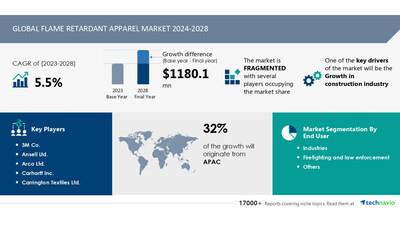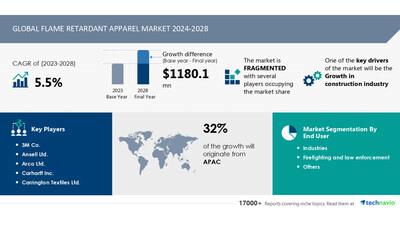
Flame Retardant Apparel Market To Grow By USD 1.18 Billion From 2024-2028, Driven By Growth In Construction Industry, Report On AI-Driven Market Transformation - Technavio
| Forecast period |
2024-2028 |
| Base Year |
2023 |
| Historic Data |
2018 - 2022 |
| Segment Covered |
End-user (Industries, Firefighting and law enforcement, and Others), Distribution Channel (Online and Offline), and Geography (North America, APAC, Europe, South America, and Middle East and Africa) |
| Region Covered |
North America, APAC, Europe, South America, and Middle East and Africa |
| Key companies profiled |
3M Co., Ansell Ltd., Arco Ltd., Carhartt Inc., Carrington Textiles Ltd., Cintas Corp., DEVA FM. Sro, DuPont de Nemours Inc., Frham Safety Products Inc., Honeywell International Inc., Hultafors Group AB, Hydrowear BV, Kimberly Clark Corp., Lakeland Industries Inc., Marina Textil SL, National Safety Apparel Inc., Portwest Clothing Ltd., Scandia Gear Europe BV, Seyntex NV, and VF Corp. |
Wearable technology is revolutionizing various industries, including protective equipment , by ensuring enhanced employee safety and productivity. The industrial sector, particularly in industries like mining, automotive, and construction, is increasingly adopting wearable technology as a subset of the IoT . This technology, which includes smartwatches, fitness trackers, and wearable sensors, is being used to collect data and provide vital information in a faster and more convenient way. In the protective equipment segment, the incorporation of wearable technology in flame retardant apparel is a new trend. Wearable devices are being used to detect beacons attached to PPE, ensuring that workers are wearing the required protective equipment. This not only enhances safety management on the site but also helps prevent accidents, ultimately leading to long-term cost savings for employers. Manufacturers in the PPE industry are investing in smart and wearable technology to differentiate their products and meet the evolving needs of industries. However, the challenge lies in ensuring user-friendliness and comfort, as industrial workers need to wear these devices for extended periods. Another trend in protective equipment is the use of augmented reality (AR) to help access hazardous environments. Heavy industries such as oil and gas, manufacturing, and mining are adopting AR devices to improve operational efficiency and safety. However, ensuring user comfort and compatibility with existing protective equipment remains a significant challenge. The global flame retardant apparel market is expected to grow significantly during the forecast period due to these technological advancements, which will enhance safety, productivity, and efficiency in hazardous industries.
The Flame Retardant Apparel Market is witnessing significant growth due to increasing demand for protective clothing in various sectors. Bedding and disposable apparel industries are key consumers, while automotive and transportation textiles also show strong demand. Polyester and PU are popular flame-resistant materials, with nylon and aliphatic thermoplastic polymers also used. Durable and semi-durable flame retardants are in use, with back-coating a common application method. Public safety services, including firefighting, require high-performance FR clothing. Halogenated products like brominated and chlorinated flame retardants are being replaced by non-halogenated alternatives, such as aluminum hydroxide (ATH). Fire retardancy is crucial for mitigating heat-related hazards and preventing burn injuries. Chemical and safety regulations drive market trends, with self-extinguishing fabrics and comfort in workwear gaining popularity. The market includes protective clothing for construction, functional clothing, and multi-utility apparel. Textile technology advances continue, with automation playing a key role.
Insights on how AI is driving innovation, efficiency, and market growth- Request Sample!
MarketChallenges
.
The flame retardant apparel market is significant in ensuring worker safety across various industries. However, challenges persist in ensuring compliance with the use of these protective garments. Comfort and fit issues are key concerns for vendors, as workers may prefer less restrictive clothing. Non-compliance poses risks for employers, particularly in developed regions, due to stringent safety regulations and potential legal and financial implications of worker injuries. Additionally, factors such as availability, training, and maintenance indirectly impact consumer compliance. Fire-resistant fabrics, while effective in preventing fire hazards, can be stiff and rigid, limiting worker mobility and dyeing options. Awareness and adherence to industrial standards are crucial to maximize the benefits of flame retardant apparel and ensure worker safety. Despite the importance of flame retardant clothing in protecting against hazards such as arc, electric, and welding flashes, incorrect use or non-compliance with industrial standards can render the apparel ineffective. These challenges may hinder the growth of the global flame retardant apparel market during the forecast period.
.
The Flame Retardant Apparel market faces several challenges in ensuring safety and compliance. Health associations raise concerns over the use of certain flame retardant chemicals, leading to stricter regulations for protective wear. Regulations for protective equipment (PPE) in industries like Oil and Gas require inherent flame retardant fabrics or treated ones. Fire-related accidents underscore the need for cost-effective alternatives and raw material shortages, causing shipping delays and supply chain management issues. Fire safety standards mandate the use of textile flame retardants and retardant fabrics in various applications, from defense and transportation to household items like curtains and carpets . The chemical compositions of flame retardants, such as halogenated retardants, brominated retardants, chlorinated retardants, antimony oxides, organophosphorus, polyolefins, epoxy resins, styrenics, nylon-blended fibers, and cellulose/viscose fibers, impact both performance and cost. Fire safety regulations continue to evolve, necessitating ongoing research and development.
Insights into how AI is reshaping industries and driving growth-
Download a Sample Report
This flame retardant apparel market report extensively covers market segmentation by
End-user-
1.1 Industries
1.2 Firefighting and law enforcement
1.3 Others
-
2.1 Online
2.2 Offline
-
3.1 North America
3.2 APAC
3.3 Europe
3.4 South America
3.5 Middle East and Africa
1.1
Industries-
The Flame Retardant Apparel Market is growing due to increasing consumer awareness and regulations. Manufacturers produce clothing with flame retardant materials to reduce the risk of fires. These materials include natural and synthetic fibers treated with retardants. The market size is expected to expand, driven by factors like growing demand from various industries, including construction, oil and gas, and military. Companies focus on research and development to improve the effectiveness and comfort of flame retardant apparel.
Download complimentary Sample Report to gain insights into AI's impact on market dynamics, emerging trends, and future opportunities- including forecast (2024-2028) and historic data (2018 - 2022)
The Flame Retardant Apparel market encompasses the production and sale of fire-resistant clothing, also known as FR clothing or flame-resistant apparel. This type of apparel is designed to protect against heat-related hazards and burn injuries, making it essential in various industries such as construction and oil and gas . The market is driven by the increasing demand for self-extinguishing fabrics and the need for protective clothing in industries with high fire risks. Textile technology plays a significant role in the development of flame retardant materials, with both inherent and treated flame retardant options available. The market is subject to regulations set by various health associations and protective wear regulations. Fire-related accidents continue to be a concern, driving the need for cost-effective alternatives and automation in the production process. Raw material shortages and shipping delays are challenges in the supply chain management of flame retardant apparel. Digital platforms have emerged as a key distribution channel, offering safety information and enabling the purchase of flame retardant apparel online. Overall, the market for flame retardant apparel is a critical component of personal protective equipment (PPE) and plays a vital role in ensuring workers' safety.
Market Research OverviewThe Flame Retardant Apparel market refers to the production, sale, and use of fire-resistant clothing and textiles. Fire-related hazards and burn injuries are significant concerns in various industries, particularly construction, oil and gas, defense, transportation, and public safety services. Flame retardant materials, such as self-extinguishing fabrics, are essential for protective clothing and personal protective equipment (PPE) to ensure safety in work environments. Textile technology plays a crucial role in the development of flame retardant apparel, with inherent and treated flame retardants used in different fabric compositions. These include halogenated retardants like brominated and chlorinated retardants, non-halogenated retardants like aluminum trihydroxide and antimony oxides, and organophosphorus compounds. The market for flame retardant apparel is subject to various regulations and safety standards, including those set by health associations and protective wear regulations. The use of flame retardants in textiles has been a topic of debate due to concerns over their chemical compositions and potential health risks. Cost-effective alternatives and raw material shortages are challenges in the flame retardant apparel market. Digital platforms and automation are being used to streamline supply chain management and ensure timely delivery of flame retardant apparel to various industries. Flame retardant apparel is used in various applications, including multi-utility workwear, protective clothing, and fire safety standards. The market includes applications in household items like curtains, carpets, and bedding, as well as disposable apparel, automotive sector, and polyester applications. Flame retardants are also used in various industries, including transportation textiles, firefighting, and engineering thermoplastics. The market for flame retardants is expected to grow due to increasing awareness of fire safety and regulations, as well as the need for durable and semi-durable flame retardants. Fire safety standards and regulations play a significant role in the flame retardant apparel market, with regulations set by various organizations, including OSHA, NFPA, and European Union. The market for flame retardant apparel is expected to grow due to the increasing number of fire-related accidents and the need for protective clothing and PPE. Flame retardant apparel is essential in various industries to ensure workers' safety and prevent burn injuries. The market for flame retardant apparel is expected to grow due to the increasing awareness of fire safety and regulations, as well as the need for cost-effective alternatives and raw material shortages. The use of flame retardants in textiles is a complex issue, with concerns over their chemical compositions and potential health risks, making it essential to ensure that regulations and safety standards are met to protect workers and consumers.
Table of Contents:1 Executive Summary
2 Market Landscape
3 Market Sizing
4 Historic Market Size
5 Five Forces Analysis
6 Market Segmentation
-
End-user
-
Industries
Firefighting And Law Enforcement
Others
-
Online
Offline
-
North America
APAC
Europe
South America
Middle East And Africa
7
Customer Landscape
8 Geographic Landscape
9 Drivers, Challenges, and Trends
10 Company Landscape
11 Company Analysis
12 Appendix
Technavio is a leading global technology research and advisory company. Their research and analysis focuses on emerging market trends and provides actionable insights to help businesses identify market opportunities and develop effective strategies to optimize their market positions.
With over 500 specialized analysts, Technavio's report library consists of more than 17,000 reports and counting, covering 800 technologies, spanning across 50 countries. Their client base consists of enterprises of all sizes, including more than 100 Fortune 500 companies. This growing client base relies on Technavio's comprehensive coverage, extensive research, and actionable market insights to identify opportunities in existing and potential markets and assess their competitive positions within changing market scenarios.
ContactsTechnavio Research
Jesse Maida
Media & Marketing Executive
US: +1 844 364 1100
UK: +44 203 893 3200
Email:
[email protected]
Website:
SOURCE Technavio
WANT YOUR COMPANY'S NEWS FEATURED ON PRNEWSWIRE? 440k+Newsrooms &
Influencers 9k+
Digital Media
Outlets 270k+
Journalists
Opted In GET STARTED

Legal Disclaimer:
MENAFN provides the
information “as is” without warranty of any kind. We do not accept
any responsibility or liability for the accuracy, content, images,
videos, licenses, completeness, legality, or reliability of the information
contained in this article. If you have any complaints or copyright
issues related to this article, kindly contact the provider above.



















Comments
No comment